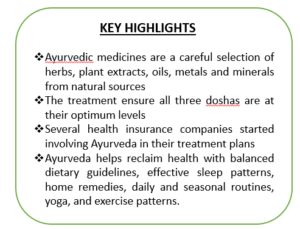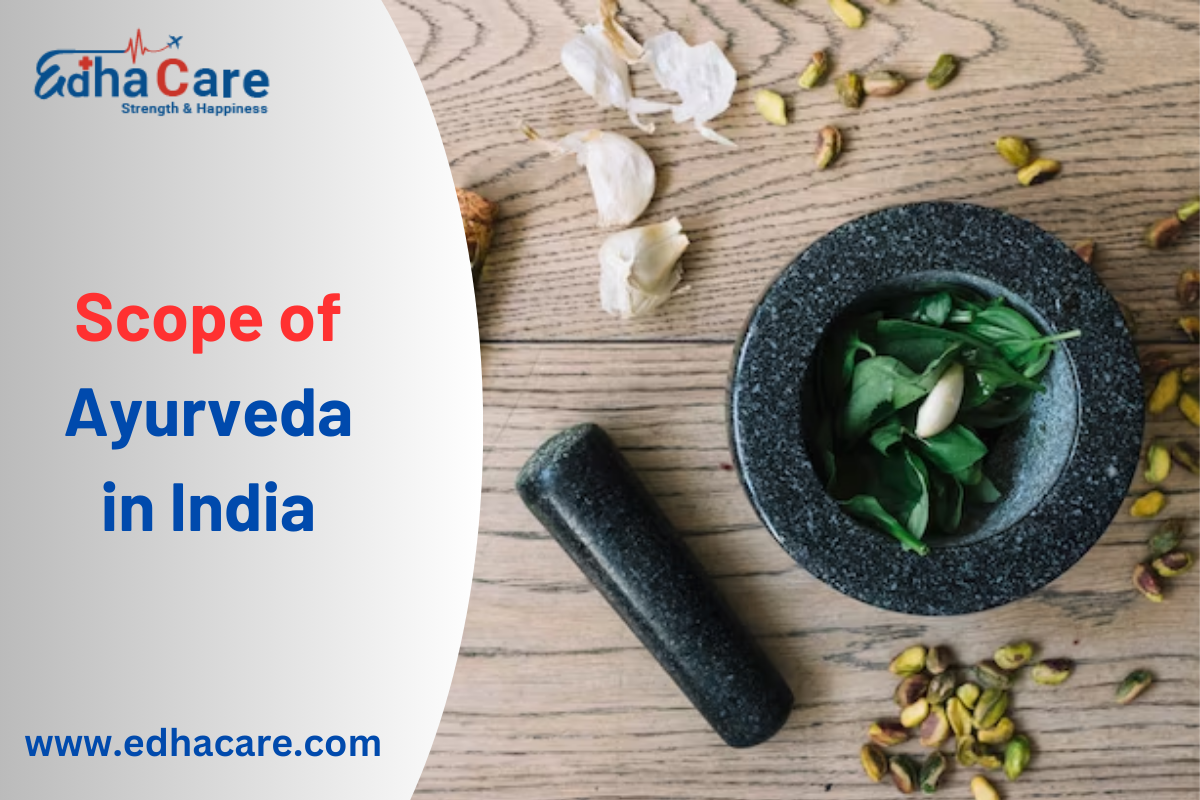Clinical treatment is something that we go for with regard to any sort of treatment. But in recent times, the field of Ayurveda has emerged significantly. The benefits and importance of Ayurveda have grown on a huge basis and it is really helping people in a long way. Ayurvedic medicine is one of the world’s oldest holistic healing systems for the whole body. It was developed more than 3,000 years ago in India. We are here to discuss the huge scope of Ayurveda in India.
What is Ayurveda?
In India, Ayurveda is considered a form of medical care that is equivalent to conventional Western medicine, traditional Chinese medicine, naturopathic medicine, and homeopathic medicine. There are different practitioners of Ayurveda in India who undergo state-recognized, institutionalized training. In recent times, Ayurvedic practitioners are not licensed in the United States, and there is no national standard for Ayurvedic training or certification. Although, Ayurvedic schools have received approval as educational institutions in some states. With time, it has been seen that there is a huge scope of Ayurveda in India.
Several Ayurvedic materials have not been thoroughly studied in either Western or Indian research. Some of the products that are used in Ayurvedic medicine contain herbs, metals, or other materials that may be harmful if used without the direction of a trained practitioner. Additionally, ayurvedic medicines are regulated as dietary supplements rather than as drugs in the U.S.. Thus, they are not necessitated to meet the safety and efficacy standards for conventional medicines.
The Trend of Ayurveda over the Years
It has been noticed that over the years, the scope of Ayurveda in India has increased a lot. Modern medicine has grown at a huge rate recently, especially in the Indian market, which meant that Ayurveda has been sidelined to a large extent. As per a new report from Big Four accounting and advisory PwC\, however, the sector has been resurgent in recent times, brought about by a shift in strategy.
Much like any other industry, the sector has also turned to technological advancement to develop its capabilities and maintain relevance in the contemporary scenario. Not only has the whole set of Ayurvedic treatments established a stronghold in the Indian market, but they have also begun to displace some of the most prominent healthcare firms in the country.
Below is the graph to showcase the trend of the Ayurveda market in India from 2015-2022.
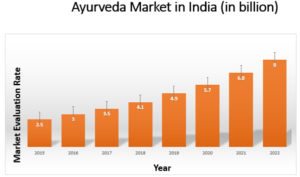
Ayurveda and Energies of Life
According to Ayurveda, there are three fundamental energies that regulate the well-being of a person. These are:
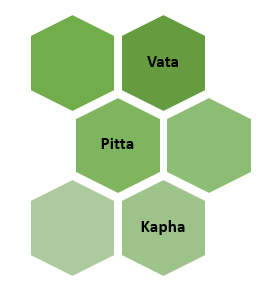
-
Vata Dosha
People who practice Ayurveda believe this is the strongest of all three doshas. It controls very basic body functions, such as how cells divide. It also controls your mind, breathing, blood flow, heart function, and the ability to get rid of waste through your intestines. Furthermore, things that can disrupt it include eating again too soon after a meal, fear, grief, and staying up too late. If Vata dosha is the main life force, is it more likely to develop conditions such as asthma, anxiety, heart disease, skin problems, and rheumatoid arthritis.
-
Pitta Dosha
Pitta Dosha helps in controlling digestion, metabolism, and certain hormones that are associated with the appetite. There are a few things that can disrupt it are eating sour or spicy foods and spending too much time in the sun. This type of condition is more likely to develop diseases such as Crohn’s disease, heart disease, high blood pressure, and infections.
-
Kalpa Dosha
This life force helps in controlling muscle growth, body strength and stability, weight, and the immune system. One can disrupt it by sleeping during the day, eating too many sweet foods, and also eating or drinking many things that contain too much salt or water. If this is the main life energy, practitioners believe one may develop asthma and other breathing disorders, cancer, diabetes, nausea after eating, and obesity.
Advantages of Ayurvedic Treatment
There are several benefits that are associated with Ayurvedic treatment. These benefits surely enhance the scope of Ayurveda in India.
- It reduces stress on the mind and helps to work better on physical and mental health and strike a balance between the two.
- It assists to reduce excess fat accumulated in the body and maintains it with the natural exercise prescribed by the treatment.
- It majorly focuses on the inner strength of the body, which, as a chain reaction follows, will affect the outer appearance, giving one a healthy, glowing, and happy feeling from the inside out.
- Ayurvedic treatment has also been successful in avoiding diabetes and high blood pressure, which these days have been a major cause of dangerous diseases.
- Lack of proper diet, unhealthy eating routines, and bad digestion can lead to inflammation. The root cause of neurological diseases, cancer, diabetes, cardiovascular problems, pulmonary diseases, arthritis, and many others starts with inflammation.
- A cleansed body in turn helps for improved overall health. There are suitable home remedies that are greatly used in Ayurvedic herbal medicines are cumin, cardamom, fennel, and ginger which cure indigestion in the body and prevent bloating.
- Ayurvedic herbs and essential oils help increase blood flow, complement blood circulation, and draw out toxins from the body through the skin.
Different Ayurvedic Treatment Types
Here, in this section, we discussed some popular Ayurvedic treatments that work holistically to balance doshas and ensure perfect harmony between your mind, body, and soul to start self-healing. All these treatment types and their wide availability surely increase the scope fo Ayurveda in India.
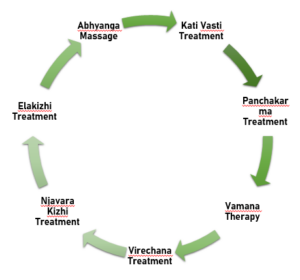
1. Abhyanga Massage
Abhyanga is a type of traditional full-body massage that is performed by oneself using medicated oil. The oil is mildly heated before applying to the entire body, from head to toe. It is later followed by gentle strokes to release stress. This will further improve circulation and relieve inflammation. The oil is infused with particular herbs, and the ingredients may vary depending on the target ailment.
2. Kati Vasti Treatment
Kati Vasti is a traditional treatment for back pain and inflammation in the lumbosacral region. It is well-performed by keeping a warm medicated oil over the lower back for a specific duration. It is kept in a small frame or is made of gram dough to keep the oil. The heated oil puddles over the target region to provide external stimulation for a soothing effect.
3. Elakizhi Treatment
In our current life, we lack daily physical activities which can hamper our overall health. Perspiration is good for people. It helps open up skin pores and eliminate toxins such as sweat. Elakizhi therapy induces perspiration by massaging the body with a bundle of herbs packed in a muslin cloth and soaked in warm oil. The treatment helps relieve stress, sore muscles, and body ache.
4. Panchakarma Treatment
Panchakarma is a holistic treatment that is performed over a week to naturally send the body into overdrive to eliminate toxins. This treatment has been around for several centuries, designed and prescribed by ancient sages to nurture healthy living.
5. Vamana Therapy
This therapy includes administering medicated oil or ghee for a few days to agitate doshas and eventually induce vomiting. Vamana is performed for treating illnesses caused by elevated Kapha doshas by eliminating toxins from the tissues.
Besides all these, there is another type of ayurvedic treatment also which is very basic at the same time, and very useful as well. It is known as a medicated steam bath.
Certain leaves and herbs are passed to the whole body with steam for around 10-20 minutes. This is generally done to cure skin disease, reduce impurities from the body, enhance the tone of the body, and reduce fat.
Is Ayurvedic Treatment Cost-Effective?
Ayurveda in India is considered very much reasonable and suitable for the budget of middle and low-income groups. The varied price ranges for varied treatments such as Panchkarma treatment are charged around INR 200-1500 per day. The majority of the people in India opt for Ayurvedic medicines for the treatment of numerous illnesses. These are plant-based medicines, and as they’re completely natural, several people trust these ancient and clean treatments. Currently, many of the insurers are including traditional medicines across all types of health insurance plans. Several health insurance companies are covering Ayurveda, but traditional medicines such as Unani, Naturopathy, and others are not covered yet under health plans.
Thus, overall it can be said that Ayurveda has developed well enough and that it has been accepted in India on a large scale. With its holistic approach and natural methods, Ayurvedic treatment works towards a permanent cure. The medicines of Ayurveda are also according to the individual dosha imbalance.
